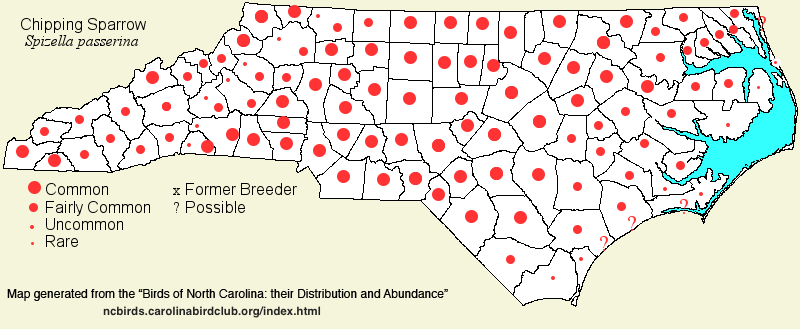 |  |
|
Chipping Sparrow - Spizella passerina PASSERELLIDAE Members: | Search Common: Search Scientific: |
|
|
|||||||
| General Comments | The Chipping Sparrow has been one of the most successful birds in North America over the past few decades. It nests over most of the continent, and it winters in the southern part of the United States. Until a few decades ago, it was a rare to absent breeder in the coastal counties of North Carolina, but it has adapted to parks, golf courses, extensive lawns, and open pinewoods, as well as to farmyards, such that it nests in all 100 counties -- wherever very short grasses (usually mowed) are present. With the warming of winters in the past few decades, winter survival has increased, and this formerly uncommon wintering species is now locally common in the southeastern portion of the state. Winter habitats are somewhat different from that of breeding birds, as they gather into flocks of often several dozen birds, trooping around with Eastern Bluebirds, Pine and Yellow-rumped warblers, and other sparrows, feeding mostly in short grass along roadsides, fallow fields and stubble fields, and open woods. They also visit feeders in winter. | ||||||
| Breeding Status | Breeder | ||||||
| NC BRC List | Definitive | ||||||
| State Status | |||||||
| U.S. Status | |||||||
| State Rank | S5B,S5N | ||||||
| Global Rank | G5 | ||||||
| Coastal Plain | Permanent resident, with strong migratory movements; increasing. In summer, common in the western and central portions, and fairly common in the eastern portions, though uncommon within perhaps 5 miles of the coast. Probably does not yet nest on the Outer Banks. Common to very common in migration. In winter, common (though occurs in flocks, and thus can be erratic) in the southern half of the province, from Croatan National Forest to the Sandhills; fairly common in the northern portion, though can be scarce after severe weather. Peak counts: | ||||||
| Piedmont | Permanent resident, with strong migratory movements; increasing. In summer, common to very common, and widespread across the province. Very common in migration. In winter, fairly common (to locally common) in the eastern and southern portions, uncommon to locally fairly common in the central portions, but uncommon in the western/foothill portions. Peak counts: | ||||||
| Mountains | Permanent resident, with strong migratory movements; scarce in winter. Common in the lower and middle elevations, but less widespread than downstate; local to 5,000 feet, and scarce to 6,000 feet. Common in migration. In winter, rare to uncommon in early winter at lower elevations, but rare by midwinter; a few likely overwinter. Quite rare in winter at middle elevations. Peak counts: | ||||||
| Finding Tips |
None needed. **** | ||||||
| Attribution | LeGrand[2023-03-31], LeGrand[2012-11-04], LeGrand[2011-12-18] | ||||||
| NC Map Map depicts all counties with a report (transient or resident) for the species. | Click on county for list of all known species. |
| NC Breeding Season Map Map depicts assumed breeding season abundance for the species. |  |